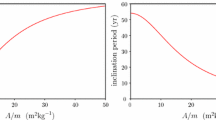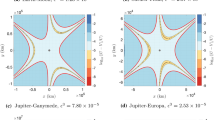Abstract
Some asteroids in Earth‐crossing orbits avoid close approaches by entering in a mean motion resonance whenever the distance between the two orbits is small. These orbits are ‘Toro class’ according to the classification of (Milani et al., 1989). This protection mechanism can be understood by a semi‐averaged model, in which the fast variables are removed and the dynamical variables are the critical argument and the semimajor axis, with dependence upon a slow parameter. The adiabatic invariant theory can be applied to this model and accounts for all the qualitative features of the orbits in this class, including the onset of the libration when the orbit distance is small. Because of the neglected perturbations by the other planets, this theory is approximate and the adiabatic invariant is conserved only with low accuracy moreover, the Toro state can be terminated by a close approach to another planet (typically Venus).
“Would you tell me, please, which way I ought to go from here?”
“That depends a good deal on where you want to get to,” said the Cat.
Alice in Wonderland, L. Carroll
Similar content being viewed by others
References
Baccili, S.: 1996, ‘Protezione per Risonanza dalle Collisioni con la Terra: gli Asteroidi della Classe Toro’, Thesis for the laurea degree in Mathematics, University of Pisa.
Barucci, M. A., Doressoundiram, A., Dotto, E., Farinella, P., Fulchignoni, M., Milani, A., Paolicchi, P., Perozzi, E. and Rossi, A.: 1998, ‘A rendezvous mission with an Earth approaching asteroid: a scenario for SMART-1’, proposal to the E. S. A., Meudon Astronomical Observatory.
Butcher, J. C.: 1987, The Numerical Analysis of Ordinary Differential Equations, Wiley, pp. 209–237.
Henrard, J.: 1993, ‘The adiabatic invariant in theory in classical dynamics’, Dynamics Reported 2, 117–235.
Janiczek, P. M., Seidelmann, P. K. and Duncombe, R. L.: 1972, ‘Resonances and encounters in the inner Solar System’, Astron. J. 77, 764–773.
Lemaitre, A.: 1984, ‘Formation of the Kirkwood gaps in the asteroid belt’, Celest. Mech. 34, 329–341.
Milani, A., Carpino, M., Hahn, G. and Nobili, A. M.: 1989, ‘Dynamics of planet-crossing asteroids: classes of orbital behavior’, Icarus 78, 212–269.
Milani, A., Carpino, M. and Marzari, F.: 1990, ‘Statistics of close approaches between asteroids and planets’, Icarus 88, 292–335.
Author information
Authors and Affiliations
Rights and permissions
About this article
Cite this article
Milani, A., Baccili, S. Dynamics of Earth‐crossing asteroids: the protected Toro orbits. Celestial Mechanics and Dynamical Astronomy 71, 35–53 (1998). https://doi.org/10.1023/A:1008387200742
Issue Date:
DOI: https://doi.org/10.1023/A:1008387200742




